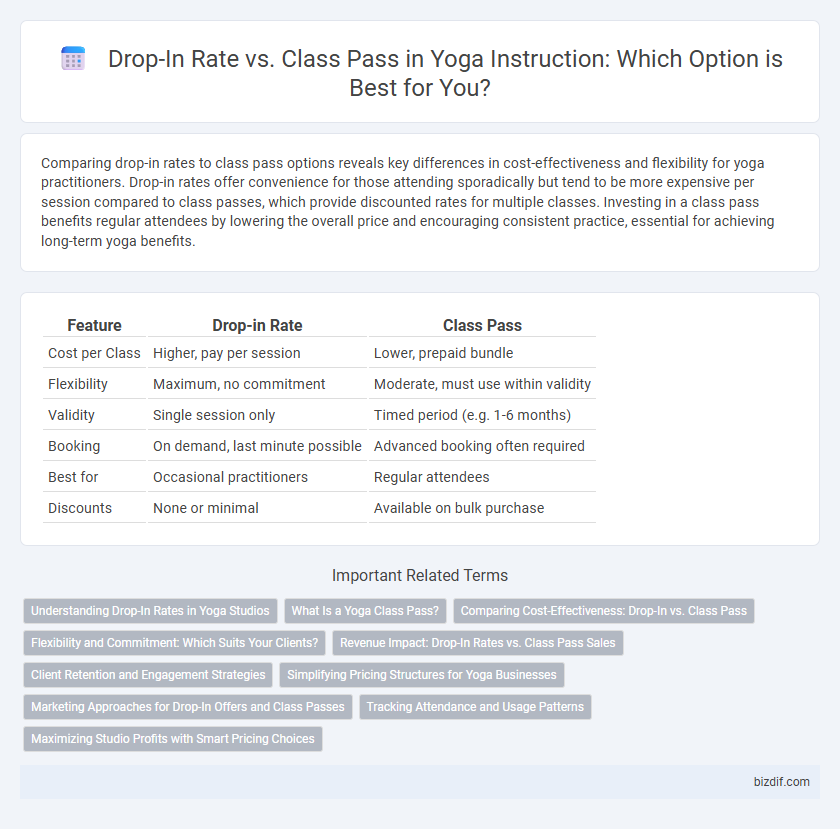Comparing drop-in rates to class pass options reveals key differences in cost-effectiveness and flexibility for yoga practitioners. Drop-in rates offer convenience for those attending sporadically but tend to be more expensive per session compared to class passes, which provide discounted rates for multiple classes. Investing in a class pass benefits regular attendees by lowering the overall price and encouraging consistent practice, essential for achieving long-term yoga benefits.
Table of Comparison
| Feature | Drop-in Rate | Class Pass |
|---|---|---|
| Cost per Class | Higher, pay per session | Lower, prepaid bundle |
| Flexibility | Maximum, no commitment | Moderate, must use within validity |
| Validity | Single session only | Timed period (e.g. 1-6 months) |
| Booking | On demand, last minute possible | Advanced booking often required |
| Best for | Occasional practitioners | Regular attendees |
| Discounts | None or minimal | Available on bulk purchase |
Understanding Drop-In Rates in Yoga Studios
Drop-in rates in yoga studios offer flexibility by allowing students to pay per session without long-term commitment, typically ranging from $15 to $25 per class depending on location and instructor expertise. Class passes provide a cost-effective option for regular attendees, often reducing the per-class price by 20% to 40% compared to drop-in rates through bundles of 5, 10, or 20 classes. Understanding the differences helps yoga practitioners choose between convenience and savings based on their attendance frequency and budget.
What Is a Yoga Class Pass?
A yoga class pass offers a prepaid bundle of multiple sessions, providing cost savings compared to paying individual drop-in rates for each class. These passes often come with flexible usage options, allowing practitioners to attend various class types or times without extra fees. Purchasing a class pass is ideal for regular yoga students seeking consistency and budget-friendly access to classes.
Comparing Cost-Effectiveness: Drop-In vs. Class Pass
A drop-in rate offers flexibility for occasional yoga practitioners, typically costing around $20 to $30 per session, but expenses can escalate quickly for frequent attendees. Class passes, such as a 10-class pack for $150, reduce the per-class cost to approximately $15, providing significant savings and encouraging consistent practice. For regular students, choosing a class pass enhances cost-effectiveness by lowering the price per session and promoting regular attendance.
Flexibility and Commitment: Which Suits Your Clients?
Drop-in rates offer maximum flexibility, allowing clients to attend yoga classes without long-term commitment, ideal for those with unpredictable schedules. Class passes provide better value and encourage regular practice by requiring upfront purchase, which suits clients seeking accountability and routine. Understanding your clients' preferences helps tailor your offerings to balance convenience and commitment effectively.
Revenue Impact: Drop-In Rates vs. Class Pass Sales
Drop-in rates generate immediate revenue per session but often result in lower overall customer retention compared to class pass sales, which encourage recurring attendance and stable cash flow. Class passes provide a predictable revenue stream, improving long-term financial planning and increasing lifetime customer value. Prioritizing class pass sales enhances revenue consistency and supports sustainable business growth in yoga instruction.
Client Retention and Engagement Strategies
Offering flexible drop-in rates attracts new clients seeking low-commitment options, while class passes encourage repeat attendance by providing cost savings and convenience. Implementing a mix of both payment methods enhances client retention through consistent engagement and fosters loyalty by rewarding frequent participation. Personalized communication and occasional incentives tied to class passes further boost long-term client commitment and community building.
Simplifying Pricing Structures for Yoga Businesses
Offering drop-in rates provides flexibility for occasional yoga practitioners, while class passes incentivize regular attendance and provide upfront revenue for studios. Simplifying pricing structures by clearly differentiating these options helps reduce customer confusion and streamlines the purchasing process. Transparent pricing models that balance accessibility with commitment can improve client retention and optimize cash flow for yoga businesses.
Marketing Approaches for Drop-In Offers and Class Passes
Drop-in rates attract new clients by offering flexibility and no commitment, making them ideal for impulsive or occasional attendees. Class passes encourage repeat visits through discounted bundles, fostering client loyalty and generating predictable revenue streams. Effective marketing for drop-in offers emphasizes convenience and accessibility, while class pass promotions highlight value savings and long-term engagement incentives.
Tracking Attendance and Usage Patterns
Tracking attendance with a drop-in rate allows yoga studios to monitor individual session purchases, providing real-time insight into class popularity and client commitment. Class passes enable detailed usage pattern analysis by aggregating multiple sessions under one account, helping identify peak times and preferred class types. Combining both methods enhances studio management by optimizing scheduling, resource allocation, and personalized marketing strategies based on attendance data.
Maximizing Studio Profits with Smart Pricing Choices
Maximizing studio profits requires balancing drop-in rates and class passes by analyzing customer preferences and attendance frequency. Offering class passes encourages repeat visits and provides upfront revenue, while drop-in rates attract casual participants and increase accessibility. Strategic pricing that incentivizes multi-class purchases boosts overall studio profitability and fosters client retention.
Drop-in rate vs class pass Infographic

 bizdif.com
bizdif.com